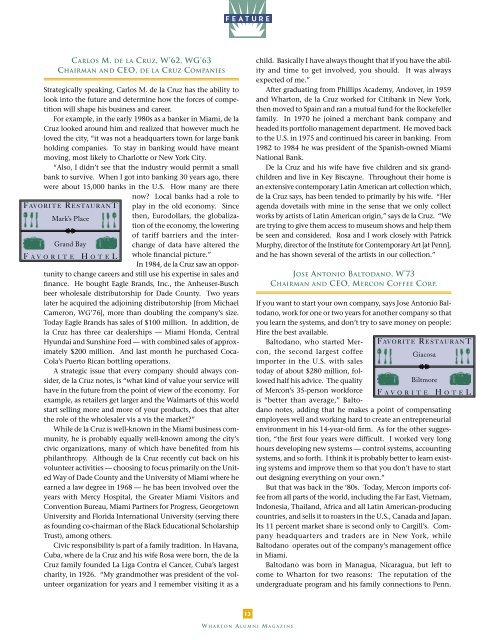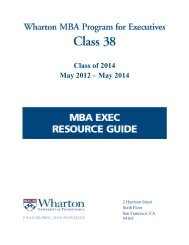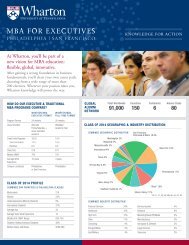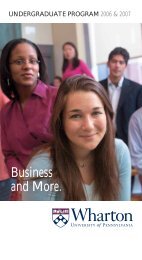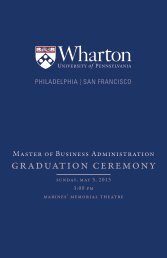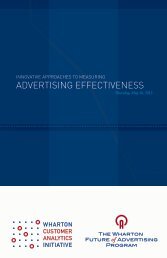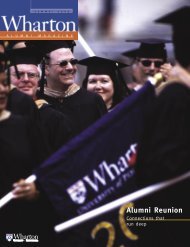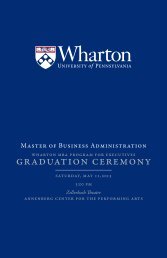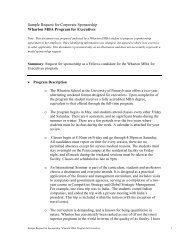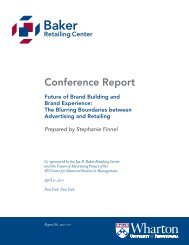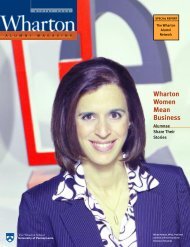wharton's prescription for health care - Wharton Magazine
wharton's prescription for health care - Wharton Magazine
wharton's prescription for health care - Wharton Magazine
You also want an ePaper? Increase the reach of your titles
YUMPU automatically turns print PDFs into web optimized ePapers that Google loves.
FEATURECARLOS M. DE LA CRUZ, W’62, WG’63CHAIRMAN AND CEO, DE LA CRUZ COMPANIESStrategically speaking, Carlos M. de la Cruz has the ability tolook into the future and determine how the <strong>for</strong>ces of competitionwill shape his business and <strong>care</strong>er.For example, in the early 1980s as a banker in Miami, de laCruz looked around him and realized that however much heloved the city, “it was not a headquarters town <strong>for</strong> large bankholding companies. To stay in banking would have meantmoving, most likely to Charlotte or New York City.“Also, I didn’t see that the industry would permit a smallbank to survive. When I got into banking 30 years ago, therewere about 15,000 banks in the U.S. How many are therenow? Local banks had a role toFAVORITE RESTAURANT play in the old economy. SinceMark’s Placethen, Eurodollars, the globalizationof the economy, the loweringrsof tariff barriers and the interchangeof data have altered theGrand BayF AVORITE H OTEL whole financial picture.”In 1984, de la Cruz saw an opportunityto change <strong>care</strong>ers and still use his expertise in sales andfinance. He bought Eagle Brands, Inc., the Anheuser-Buschbeer wholesale distributorship <strong>for</strong> Dade County. Two yearslater he acquired the adjoining distributorship [from MichaelCameron, WG’76], more than doubling the company’s size.Today Eagle Brands has sales of $100 million. In addition, dela Cruz has three car dealerships — Miami Honda, CentralHyundai and Sunshine Ford — with combined sales of approximately$200 million. And last month he purchased Coca-Cola’s Puerto Rican bottling operations.A strategic issue that every company should always consider,de la Cruz notes, is “what kind of value your service willhave in the future from the point of view of the economy. Forexample, as retailers get larger and the Walmarts of this worldstart selling more and more of your products, does that alterthe role of the wholesaler vis a vis the market?”While de la Cruz is well-known in the Miami business community,he is probably equally well-known among the city’scivic organizations, many of which have benefited from hisphilanthropy. Although de la Cruz recently cut back on hisvolunteer activities — choosing to focus primarily on the UnitedWay of Dade County and the University of Miami where heearned a law degree in 1968 — he has been involved over theyears with Mercy Hospital, the Greater Miami Visitors andConvention Bureau, Miami Partners <strong>for</strong> Progress, GeorgetownUniversity and Florida International University (serving thereas founding co-chairman of the Black Educational ScholarshipTrust), among others.Civic responsibility is part of a family tradition. In Havana,Cuba, where de la Cruz and his wife Rosa were born, the de laCruz family founded La Liga Contra el Cancer, Cuba’s largestcharity, in 1926. “My grandmother was president of the volunteerorganization <strong>for</strong> years and I remember visiting it as achild. Basically I have always thought that if you have the abilityand time to get involved, you should. It was alwaysexpected of me.”After graduating from Phillips Academy, Andover, in 1959and <strong>Wharton</strong>, de la Cruz worked <strong>for</strong> Citibank in New York,then moved to Spain and ran a mutual fund <strong>for</strong> the Rockefellerfamily. In 1970 he joined a merchant bank company andheaded its portfolio management department. He moved backto the U.S. in 1975 and continued his <strong>care</strong>er in banking. From1982 to 1984 he was president of the Spanish-owned MiamiNational Bank.De la Cruz and his wife have five children and six grandchildrenand live in Key Biscayne. Throughout their home isan extensive contemporary Latin American art collection which,de la Cruz says, has been tended to primarily by his wife. “Heragenda dovetails with mine in the sense that we only collectworks by artists of Latin American origin,” says de la Cruz. “Weare trying to give them access to museum shows and help thembe seen and considered. Rosa and I work closely with PatrickMurphy, director of the Institute <strong>for</strong> Contemporary Art [at Penn],and he has shown several of the artists in our collection.”JOSE ANTONIO BALTODANO, W’73CHAIRMAN AND CEO, MERCON COFFEE CORP.If you want to start your own company, says Jose Antonio Baltodano,work <strong>for</strong> one or two years <strong>for</strong> another company so thatyou learn the systems, and don’t try to save money on people:Hire the best available.Baltodano, who started Mercon,the second largest coffeeGiacosaFAVORITE RESTAURANTimporter in the U.S. with salesrstoday of about $280 million, followedhalf his advice. The qualityBiltmoreof Mercon’s 35-person work<strong>for</strong>ce F AVORITE H OTELis “better than average,” Baltodanonotes, adding that he makes a point of compensatingemployees well and working hard to create an entrepreneurialenvironment in his 14-year-old firm. As <strong>for</strong> the other suggestion,“the first four years were difficult. I worked very longhours developing new systems — control systems, accountingsystems, and so <strong>for</strong>th. I think it is probably better to learn existingsystems and improve them so that you don’t have to startout designing everything on your own.”But that was back in the ‘80s. Today, Mercon imports coffeefrom all parts of the world, including the Far East, Vietnam,Indonesia, Thailand, Africa and all Latin American-producingcountries, and sells it to roasters in the U.S., Canada and Japan.Its 11 percent market share is second only to Cargill’s. Companyheadquarters and traders are in New York, whileBaltodano operates out of the company’s management officein Miami.Baltodano was born in Managua, Nicaragua, but left tocome to <strong>Wharton</strong> <strong>for</strong> two reasons: The reputation of theundergraduate program and his family connections to Penn.13W HARTON ALUMNI MAGAZINE


